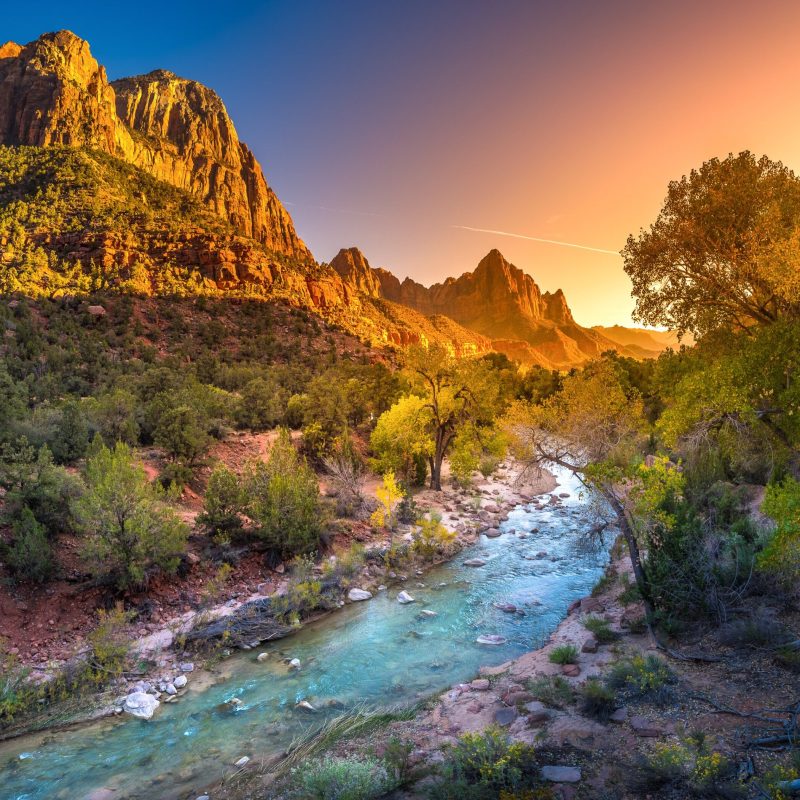
Zion National Park in southern Utah is a spectacular collection of canyons and peaks made of red sandstone. The Virgin River runs through their midst. Zion has an abundance of activities for everyone, from experienced backpacking hikers and climbers to those who enjoy walking and visiting museums. Here are our top suggestions for getting the most of your visit to Zion National Park, plus how to get there.
Videos by TravelAwaits
Ride The Shuttle To The Last Stop
Zion Canyon is accessible only by an air conditioned shuttle that runs on Zion Canyon Scenic Drive from spring through November. This trip is the perfect introduction to the park, taking about 40 minutes to reach the last stop. Get on at the Visitor Center and make your way to the ninth and last stop at the Temple of Sinawava. Along the way you’ll enjoy a narrated tour that touches on all the sites there are to see, plus their history, and an explanation of the geological formation of the park. Shuttles depart every few minutes. From the first to the last stop, you’ll go from about 500 feet in elevation to 4,400 feet.

Hike To Angels Landing
Hiking is the most popular activity in Zion and the most famous hike is the climb to Angels Landing. The Park Service rates it a strenuous hike. Find the West Rim trailhead at Shuttle Stop 6. The trail rises nearly 1,500 feet in elevation over 3.5 miles. It takes about four hours to do the entire hike (up and back). Most of the trek goes up on Walter’s Wiggles switchbacks. Hiking some of the switchbacks may be enough. If you finish those, you’ll be at Scout Lookout, where you’ll drink in amazing views. To continue past this point is to take the chain-guided path, with precarious drop offs on either side, to get all the way to the top of Angels Landing — 5,790 feet.

Walk The Narrows
At Shuttle Stop 9 is the Temple of Sinawava. This is the start of the one-mile Riverside Walk, which has an easy rating. You’ll walk along the Virgin River in between soaring canyon walls until you get to the entrance to The Narrows. This asphalt path has no strenuous climbing involved, but there are grades along the way. You can climb down and walk next to the river for part of the way, aided by the many paths and stairs built in to help you down and back up. This trail is at the highest elevation of any road in the park (4,418 feet), so keep that in mind and rest as needed at one of the many benches along the way.
At the end of the Riverside Walk, your adventure continues if you enter the ankle-deep river to trek through The Narrows, so named because it is actually a slot canyon. Here you’ll don your rubber shoes and pants, gather your walking sticks and, of course, take a selfie. You will walk entirely in water, as there is no dry land in this canyon. You can hike as far as a day — it’s 10 miles to Big Spring — without a permit. Many people walk just a mile or two in order to have the experience. You can rent gear right outside the pedestrian entrance to the park. It’s quite common to see people already in their gear on the shuttle.
Get Out In The Wilderness
Zion is renowned for its wilderness backpacking, canyoneering, and rock climbing. Overnight backpacking and climbing require permits as does any canyoneering. There are 90 miles of beautiful views on the wilderness backpacking trails through stunning canyons where you may encounter wildlife (hopefully at a distance) and desert foliage.
Canyoneering includes rappelling into the many canyons that comprise the park. Climbing requires skill due to the soft nature of the sandstone. For any of these activities, you need to bring and wear appropriate gear including water, and meet with a ranger to discuss your plan to safely get into and out of the wild. Many of the wilderness trails are strenuous and require climbing, have steep grades, and have no safety rails. It’s these experiences that draw people year after year, and you can certainly tailor a Zion wilderness experience to your abilities and needs.

Robyne Stevenson
Commune With The Patriarchs
One of my favorite places to marvel at Zion’s sandstone peaks is the Court of the Patriarchs. Get off at Shuttle Stop 4 and follow the walkway (which involves steep switchbacks). It’s worth the short climb to the viewing deck to have an unimpeded view of the three peaks that rise to over 6,800 feet. The Patriarchs were so named in 1916 when a local minister envisioned them as Isaac, Abraham, and Jacob. The red sandstone is mesmerizing.

Drive What Was Once The Longest Auto Tunnel In The U.S.
At the east entrance to the park is a one-mile car tunnel. The Zion-Mount Carmel tunnel cuts through sandstone and was the longest of its kind in the U.S when it opened for traffic in 1930. Marvel at the engineering required to keep the tunnel functioning. The tunnel is inside the park and upon exiting the tunnel going west, the driver will have to navigate a significant series of switchbacks to get to the heart of the park. The tunnel does not accommodate bicycles or pedestrians, and RVs must buy a permit for travel because traffic must be held to one-way while they drive through.
Dig Into Natural History
A respite from the heat is available for you inside the Human History Museum located at Shuttle Stop 2. The collections focus on indigenous culture and contributions to the area, how the park was built, and early Western settlers. If your interest is piqued, head to the Visitor Center for a schedule of Ranger talks as well as an opportunity to find out which archeological sites, including pictographs, might be open for viewing during your stay.

Overnight In The Park
The Zion Lodge is at Shuttle Stop 5 and offers both traditional hotel rooms and cabins for visitors to stay in the park. There are three campgrounds for RVs and tent campers, too. The South and Watchman Campgrounds are near the south park entrance and Visitor Center. Lava Point is a primitive campsite near the Kolob Canyons on the far northwestern side of the park. This area of the park is over 7,800 feet in elevation (3,000 feet higher than the main park area).
Reserve campground sites early as they go quickly and are fully booked in the prime seasons. Backpackers can reserve overnight tent sites on trails and request permits. These reservations open on a rolling basis several months in advance. Rock climbers can also stay overnight on their climbs if they have a permit.
Watch Amazing Sunsets And See Brilliant Stars
Don’t miss the evening sunsets and stargazing. Watch the sunset on the mesas and the peaks by facing east. As the sun sets behind you, its rays on the red rock create a light show like no other. The different strata in the mesas and peaks will catch the light and change colors before your eyes. Stargaze in the park where city light is low. Rangers lead stargazing talks in the Watchman campground amphitheater.

Beware The Weather
Zion National Park is open all year. Spring and fall are the most popular times to visit, though summer sees a large share of tourists as well, despite the 90-degree temperatures that continue into September. Winter snow, summer thunderstorms, and flash floods are the weather conditions you may encounter in the park. Visitors will see daily flash flood warning levels as the Virgin River can become a torrent very quickly when rain occurs in the park. Flash flooding is mainly a concern for those on the wilderness trails where permits are required, but also for those who walk The Narrows, so stay informed before heading out for the day.
How To Get Into Zion
The entry pass to Zion National Park is $20 for pedestrians arriving at the Springdale entrance and $35 if you come by car to either the East or South entrances. Parking is available inside the park but fills early each day. A single pass affords you seven consecutive days of entry. Of course your America The Beautiful annual or lifetime pass gives you free entry. Other than campground and lodging reservations, permits, and restaurants, there are no charges for any activities in the park.
The small town of Springdale, outside the southern entrance to the park, caters to some of the over 4 million people who visit the park each year. Springdale has a free bus that will take you right to the park’s pedestrian entrance, which could be a great option for you and your travel companions.

